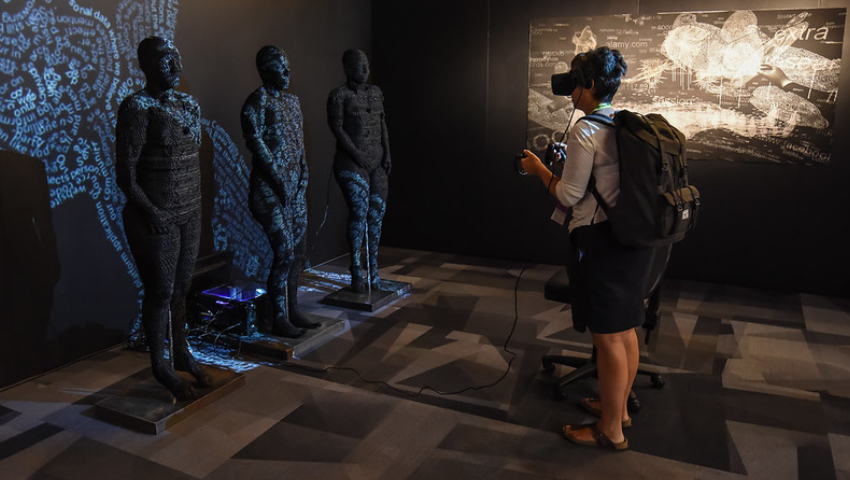photo by John Fujii © 2022 ACM SIGGRAPH
Art Papers is a SIGGRAPH program that brings together artists, researchers, and scholars working at the nexus of technology and arts. After an exciting SIGGRAPH 2022, Art Papers Chair Daniel Cardoso Llach (Carnegie Mellon University) reflected on the program’s success, the introduction of roundtables, and some key themes that came out of the contributions. Learn more from Daniel below, and be sure to check out Art Papers content on the SIGGRAPH 2022 virtual conference platform, available through 31 October.
SIGGRAPH: Congratulations on a successful Art Papers program! Tell us about your experience leading the program during this first year back in person since 2019.
Daniel Cardoso Llach (DCL): It was a joy to be this year’s Art Papers chair and to return to an in-person (and first-ever hybrid) event in Vancouver. I was very happy with the results of the review process, the special issue of the PACMCGIT journal “Art/Tech Relocations,” as well as with the in-person event. I think that the parts of the process I most enjoyed were, first, the deliberations with the jury about each paper during the review process — I feel like we all learned a lot from the authors and from each other and was thrilled to see the group engaging with each contribution in a collegial spirit. Second, meeting the authors in person and seeing them interact with the audience and with each other was really a highlight for me. As I wrote in the introduction to the issue, research and scholarship are never solely the work of individuals but of collaborative and creative communities. The SIGGRAPH Art Papers is one of the most vibrant ones I know.
SIGGRAPH: What do you hope SIGGRAPH participants took away from Art Papers during SIGGRAPH 2022?
DCL: After two years on the screen, the Art Papers community showed that it’s alive and kicking. I hope participants took away a sense that artistic and scholarly sensibilities are meant to not just follow but also guide technological research.
SIGGRAPH: Roundtables were a new addition to the SIGGRAPH conference this year. Can you share any key highlights from the Art Papers roundtable sessions?
DCL: Roundtables gave authors an opportunity to interact with the audience more informally, and this created the opportunity for very interesting conversations. I should note that the Art Papers sessions also included a panel discussion moderated by a session chair, so we had the best of all worlds — presentations, moderated discussion, and interactive sessions. I think this worked marvelously, as it gave the audience different levels of insight and access to the work.
SIGGRAPH: What themes stood out to you from this year’s selected submissions?
DCL: The jury’s selection was very diverse but soon I started to identify a few prevailing themes, which I used to organize the special journal issue. The first is “Intelligences,” represented by artistic research that mobilizes artificial intelligence and machine learning methods towards aesthetic, material, and cultural questions. The second is “Realities,” represented by works that mobilize virtual and augmented reality techniques to instigate new kinds of embodied and tangible experiences. The third and last one is “Visions,” which grouped works using computer vision, image capture, and visualization techniques as vehicles for artistic expression, civic engagement, or historical inquiry. Along these three themes or vectors, the SIGGRAPH 2022 Art Papers program offered a lively picture of a creative community expanding (and critically reflecting on) the juncture of technology and the arts.
SIGGRAPH: “Traditional African Dances Preservation Using Deep Learning Techniques” took home the title of Best Art Paper. How did you select that submission as best paper?
DCL: The jury voted for this paper from the three top-ranked submissions to the program, and I was extremely happy with their selection. Adebunmi Odefunso and her team’s work contains many lessons about rigor and cultural sensibility in arts and technology research. It shows that work can be technologically sophisticated while also addressing deep questions about artistic and cultural meaning. More specifically, this work opens many important questions about what “cultural preservation” might mean in a world where cultural data sets are increasingly available and where machine learning (and in particular deep learning) techniques offer new handles on and ways of characterizing these collections.
SIGGRAPH: Do you have any favorite moments or memories from SIGGRAPH 2022 to share with the audience?
DCL: Each of the sessions was unique in its own way. I want to celebrate how each of the chairs — Gabriela Aceves Sepúlveda, Andrés Burbano, and Nicolas Henchoz — expertly brought something special to these conversations, folding into them aspects of their own research and scholarly lenses, but also of their personalities and even humor. This made them very “real” in ways that I think the authors and other participants truly appreciated. I certainly did!
SIGGRAPH: Art Papers content is still available on-demand in the virtual conference platform. Are there any highlights participants should check out?
DCL: Watch and read them all! There’s something for everyone.
SIGGRAPH: What advice do you have for future SIGGRAPH Art Papers contributors?
DCL: The SIGGRAPH Art Papers is really a unique haven for artistic research and scholarship that is rigorously reviewed and thoughtfully shepherded. It offers arts and technology scholars and practitioners a place to share and learn from each other and to give their work unparalleled scholarly visibility. It’s also an evolving community in constant creative renewal, critically reflecting on the role of technology in the arts, and the role of the arts in a technological society. Be part of that conversation!
You heard it from Daniel! Watch and read all SIGGRAPH 2022 Art Papers contributions in the virtual conference platform, available until 31 October. Interested in submitting your artistic research to a future SIGGRAPH conference? Stay tuned for SIGGRAPH 2023 submissions, opening later this year.



